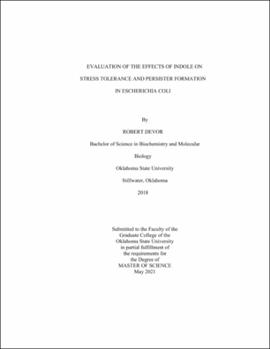| dc.contributor.advisor | Wilson, Kevin | |
| dc.contributor.author | Devor, Robert | |
| dc.date.accessioned | 2021-09-23T19:51:49Z | |
| dc.date.available | 2021-09-23T19:51:49Z | |
| dc.date.issued | 2021-05 | |
| dc.identifier.uri | https://hdl.handle.net/11244/330860 | |
| dc.description.abstract | Bacteria can adapt to many unfavorable conditions that can arise in their environment. Persister cells are a specific phenotype that can occur within a small fraction of a genetically identical population of cells. This phenotype is characterized by a state of temporary metabolic quiescence that enables the individual cell to survive stresses such as antibiotics that might kill the majority of the population. This presents a significant challenge to the treatment of chronic bacterial infections because persister cells enable the continuation of an infection and can enable the emergence of antibiotic resistance. | |
| dc.description.abstract | The compound indole, produced by the enzyme tryptophanase, is one of many proposed signals that promotes persister cell formation. Tryptophanase mainly produces indole during the stationary phase of bacterial growth, which occurs after the logarithmic stage of growth when persister cells are typically assayed. | |
| dc.description.abstract | Using Escherichia coli as a model, we evaluated the effect indole on stationary phase bacteria as it pertains to several factors of persister cells and indole signaling. Utilizing a qualitative dye, the ability for persister cells to resume growth following antibiotic treatment was examined based on differences in the presence of indole. The ability of indole to function as a signaling molecule that can induce the persistence phenotype in other cells was assayed by comparing the survival of indole non-producing cells when grown in a culture with indole-producing cells. Finally, we sought to explore the model for indole signaling by evaluating the effect on survival that could be introduced by removing the expression of proteins that are believed to be involved in indole signaling. We saw that low concentrations of indole induces a physiological change that influences cells to leave the persister phenotype. This may provide a competitive advantage over cells that are not influenced by indole and would be beneficial to bacterial in an infection while clinical treatment is occurring. A disadvantage may also occur in these cells over long-term exposure to antibiotic; the persister cells that are influenced to regrow become susceptible to antibiotic treatment. This research provides an important understanding of how indole impacts persistence by studying persistence when indole is most physiologically relevant. | |
| dc.format | application/pdf | |
| dc.language | en_US | |
| dc.rights | Copyright is held by the author who has granted the Oklahoma State University Library the non-exclusive right to share this material in its institutional repository. Contact Digital Library Services at lib-dls@okstate.edu or 405-744-9161 for the permission policy on the use, reproduction or distribution of this material. | |
| dc.title | Evaluation of the effects of indole on stress tolerance and persister formation in Escherichia coli | |
| dc.contributor.committeeMember | Morgenstein, Randy | |
| dc.contributor.committeeMember | Hartson, Steve | |
| dc.contributor.committeeMember | Hoyt, Peter | |
| osu.filename | Devor_okstate_0664M_17065.pdf | |
| osu.accesstype | Open Access | |
| dc.type.genre | Thesis | |
| dc.type.material | Text | |
| dc.subject.keywords | persisters | |
| thesis.degree.discipline | Biochemistry and Molecular Biology | |
| thesis.degree.grantor | Oklahoma State University | |
